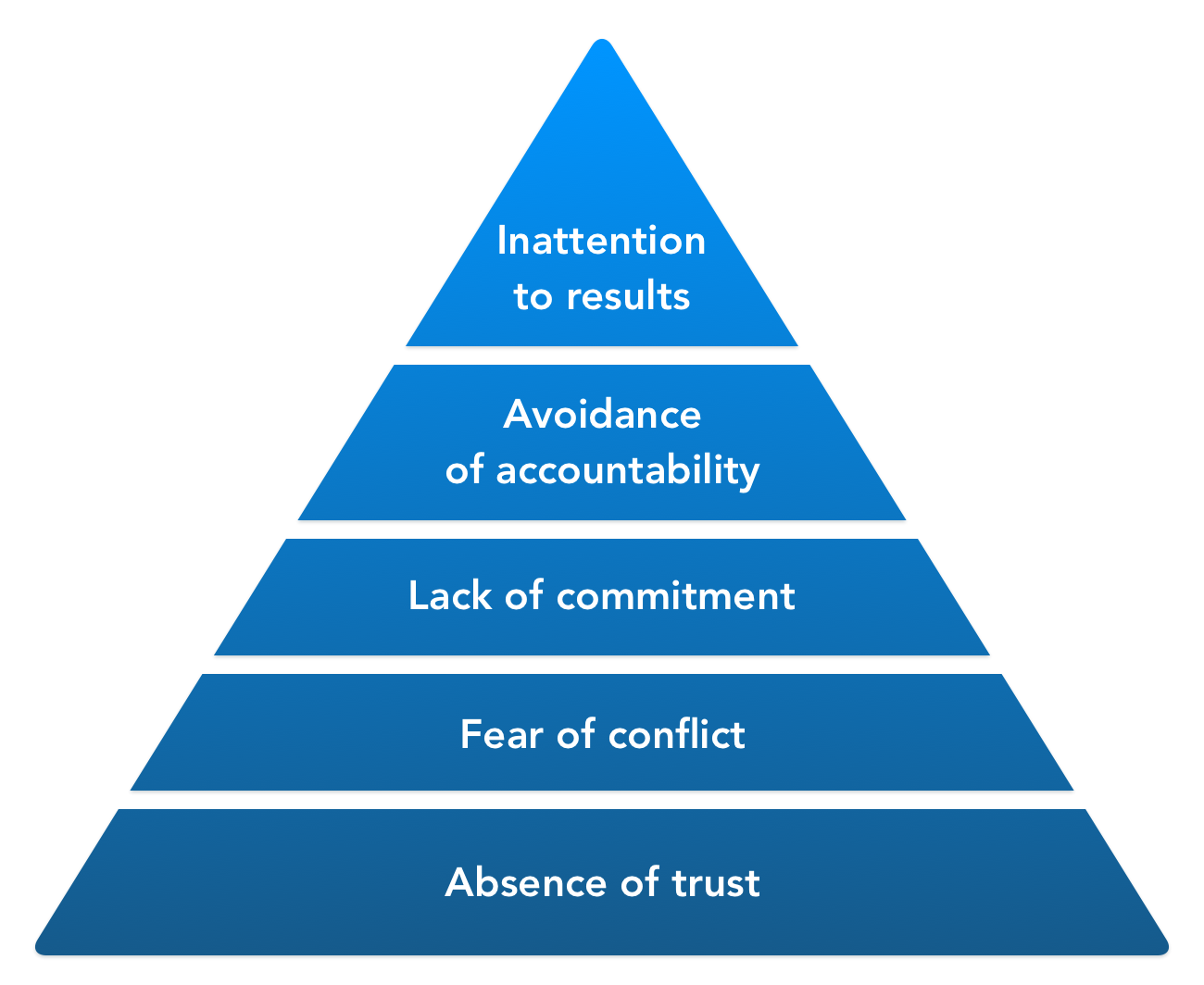I recently finished a book titled The Five Dysfunctions Of A Team, by Patrick Lencioni, and I found that the concepts it presents are so interesting that I should write about them.
This article is not intended as a substitute for the book. I hope that after reading this article you get a copy and read the ideas as presented by the author. He gives concrete examples presented as a story, while also presenting material to understand the dysfunctions and even test them in your own team.
The Five Dysfunctions
As you may have guessed, the book presents five team behaviours that prevent a team from working optimally. These dysfunctions are:
- Absence of Trust
- Fear of Conflict
- Lack of Commitment
- Avoidance of Accountability
- Inattention to Results
Working on resolving a dysfunction is a prerequisite to work on the others, this is why they are represented as a triangle. That said, we don’t need to work on them in sequence. Consider them as interrelated behaviours that can be worked in whichever way suits each team based on their specific needs.
Absence of Trust
The author explains that trust is the base of any team. This is about being able to be vulnerable, because we trust that our team will respect that vulnerability. Teams that cannot trust each other and be open about their weaknesses and fears won’t be able to work effectively. Instead, teams that have trust can engage in productive Conflict.
Fear of Conflict
Conflict is defined in the book as having different ideas, and sometimes even opposing ideas.
A team without trust, as the author explains, will be afraid of conflict. Team members may be concerned about hurting someone’s feelings, or that someone will hurt his or her feelings.
When a team embraces conflict, team are able to bring up conflicting ideas or priorities and discuss them passionately. The author explains that a person who doesn’t know the team could even believe that the team is having a strong argument. However, a team with a strong trust base will be able to have these discussions, which allows teams to Commit to decisions.
Lack of Commitment
Teams need to make decisions, but they don’t have to be by consensus (this is counterproductive for many teams). The important thing is that everyone in a team agrees with the final decision, even if that wasn’t their preferred option.
However, when teams have a Fear of Conflict, they don’t fully share their ideas, concerns or objections. As a consequence, some team members may feel unheard, and the decision loses validity. As a result, teams are not committed to their own decisions.
For a team to openly express their opinions, it needs to have overcome the Fear of Conflict. According to the author, most people are willing to commit to an idea they originally disagreed with if they feel that their perspective was genuinely heard and considered. This sense of inclusion is key for team Accountability.
Avoidance of Accountability
In this book, accountability refers to peer pressure. The author claims that rather than relying on a manager to make us accountable for our work, a better approach is to have the whole team make each of us accountable for our commitments.
For this to work effectively, a team needs to have Commitment in the first place. Without it, team members may not check on their peers, or they won’t feel responsible for delivering on expectations.
When this dysfunction is present, it leads to Inattention to Results.
Inattention to Results
Every high-performing team has goals, and they are more likely to achieve them when the whole team works towards them.
Ideally, team goals and personal goals should be aligned, but many times they are not. In teams that avoid accountability, team members tend to focus on their personal goals and objectives rather than the team results, which leads to less effective teams.
Instead, when team members make each other accountable, everyone gets their focus on working towards team goals.
Next Steps
The book not only describes these dysfunctions but also provides guidance on how to assess and address them.
To help teams evaluate their dynamics, it includes several assessment tests designed to foster self-awareness and encourage honest discussions. These tests allow teams to identify their strengths and weaknesses, helping them understand where they need to improve.
Beyond assessment, the book also suggests practical exercises to help teams overcome each dysfunction. These activities are designed to build trust, encourage healthy conflict, strengthen commitment, promote accountability, and align team members toward shared goals.
I haven’t had the chance to try these strategies yet, but when I do, I may write a follow-up article to share my experience and insights.
Cheers,
José Miguel
Share if you find this content useful.
Follow me on LinkedIn to be notified of new articles.

